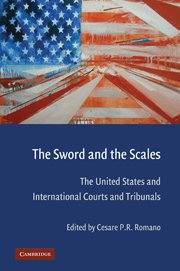In Review:
New Publications on International and Comparative Law
The Sword and the Scales: The United States and International Courts and Tribunals
Edited by Cesare P. R. Romano.
Cambridge University Press. 2009.
 Reviewed by: James G. Apple, Editor-in-Chief, International Judicial Monitor and President, International Judicial Academy
Reviewed by: James G. Apple, Editor-in-Chief, International Judicial Monitor and President, International Judicial Academy
As Professor Romano, of Loyola Law School in Los Angeles, states in the preface to this book that he edited, there has been a dearth of literature, including scholarly literature, about U.S. attitudes toward international judicial and quasi-judicial institutions, despite the growth of such institutions in recent years. He urges that “this [book] is the first comprehensive look at U.S. attitudes toward a very large range of judicial and, in the case of human rights bodies, quasi-judicial international institutions and procedures.” The reader is also cautioned in the Preface that the work is very much a “self portrait,” being a “study of attitudes and behaviors toward international courts as observed from the United States…”
This book is sorely needed to be read and studied not just by scholars, but also by judges, journalists and lawyers, if for no other reason than to show the “disconnect” between, on the one hand, the generally positive attitude of the American public toward international institutions and international courts and the “generally positive behavior of the United States” toward those institutions and courts; and on the other hand the generally negative portrayal of such institutions and courts in the popular media and within one political party.
Of the fourteen contributors to this volume, twelve are academics. The only two who are not include a former State Department Legal Advisor and an official from the Inter-American Court of Human Rights. But all are well qualified to comment on the respective subjects they have undertaken to review. And the book is not filled with long law review type articles: most of the contributions are 25 pages or less, and are considerably more readable. The two notable exceptions to the generally shorter length of the articles are an analysis of U.S. attitudes toward the International Court of Justice in The Hague (World Court) and one about U.S. relations with human rights treaty bodies.
There are two notable chapters that should be read by judges. The first is the second chapter covering “American Public Opinion on International Courts and Tribunals” by two researchers at the University of Maryland’s Program on International Policy Attitudes, Steven Kull and Clay Ramsay. The authors follow a historical approach to the subject, discussing public opinion in the U.S. about international courts and tribunals from 1942 to 2005, and then analyze public opinion on those subjects during the second term of the Bush administration in 2006. The authors, in the conclusion, note the surprising result of surveys, even in the post 9/11 world, that “there should be such majority support for accepting the jurisdiction of international tribunals over U.S. policies…” The authors conclude that “Among the American people, majority support for international tribunals has coexisted with majority support for the United Nations and the overall framework of international law.”
The second chapter for judicial scrutiny is the fifth one, by Professor Melissa Waters of the Washington University (Mo.) School of Law (and a former lecturer at the International Judicial Academy’s Sir Richard May Seminar for Judges on International Law and International Courts). The subject of this contribution is the relationship between the United States Supreme Court and the International Court of Justice and its decisions. She discusses this relationship in the context of specific Supreme Court cases which have involved decisions of the ICJ and contrasts the "conservative conception," which is characterized by a "horizontal dialogue" with the ICJ and the "vertical dialogue" with the ICJ, which is "liberal conception." The main characteristics of the dialogues are the “respectful consideration” approach of the former and the “special expertise” view of the latter. Professor Waters concludes with the observation that ‘much conceptual and theoretical work remains to be done in developing a fully articulated conception of the proper dialogic relationship between U.S. courts and international tribunals.”
Other chapters in the book deal with “Arbitration and Avoidance of War,” “U.S. Attitudes Toward International Criminal Courts and Tribunals,” “The United States and the Inter-American Court of Human Rights,” “The U.S. and International Claims and Compensation Bodies,” the “Multilateral Trade System,” and dispute resolution under NAFTA (two chapters).
Professor Romano concludes with his own personal views about the status of international courts and tribunals in the United States. He analyzes the four types of international courts according to their functions. These are (1) classical international courts, (2) human rights courts, (3) courts of regional economic and/or political integration, and (4) international criminal courts. He observes that “international courts are like Halloween haunted houses, they spook only the naïve and those that want to be spooked.” In the section on “You Cannot Have International Courts That Are Always on Your Side ”he provides the reader with a quote from Justice Robert Jackson’s famous first address to the American Society of International Law in 1945.
Professor Romano concludes with a short section that has as its theme “the United States needs international courts and international courts need the United States.” Judges, not only in the U.S., but around the world, need to take cognizance of that truth, and do what they can to make the results of that observation a reality.
